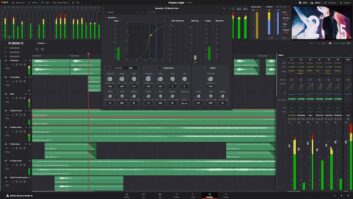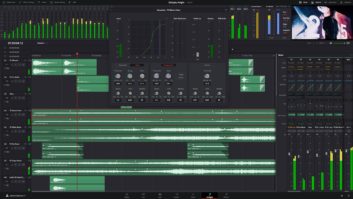Anyone who makes audio or music recordings will frequently ask themselves the question: “Does it sound good?” And if I’m about to spend my clients’ money on recording rooms they plan to rent out, the room had better “sound good”! Equally important, any product leaving that studio must “sound good” elsewhere in the known universe if I ever want to work again.
Over the past couple of years, my partners and I have spent a lot of time investigating how sound bounces around a room, particularly in the horizontal plane, and its effect on how we hear stereo recordings. Based on our collective experiences as recording engineers, a lot of good, published acoustical research and some very strong anecdotal evidence from our work with ultra-wide-dispersion loudspeakers, we believe we have pieced together a good bit of the “sounds good” puzzle. And the control room that most recently came out of this quest is “The Garden,” the new 5.1 mix room at The Plant Recording studios (Sausalito, Calif.), shown on the August ’99 cover of Mix.
With its wide-dispersion monitors and oval-shaped control room, The Garden definitely represents a departure from traditional approaches to acoustics and room design. Let’s explore this topic further, with a look at the way loudspeakers, rooms and people interact in terms of acoustics and psychoacoustics.
Starting with the obvious, loudspeakers and rooms form an acoustic transmission path. They both affect what we hear and how we perceive sounds-two VERY different, but related phenomena. Loudspeakers should have low-distortion, flat-frequency response, be free of audible resonances and have good off-axis response. At the very least, rooms must minimize standing waves and be free of excessive reverberation. On these basic points there is little, if any, disagreement. But loudspeakers also need to have horizontal coverage angles of 140degrees or more, while maintaining flat response and frequency extension well above 10 kHz. Control rooms should have hard sidewalls to make use of the off-axis acoustic power generated by such loudspeakers, and be well-damped at the front, rear and ceiling. Diffusion should by and large be avoided, particularly on the rear wall. (That is, if you have the luxury of building from the ground up. No offense to the diffusor makers here. It’s great stuff with lots of good uses.)
LOUDSPEAKERS
All loudspeakers radiate sound in every direction. If you soffitt-mount them, you constrain the output to a hemisphere, but the total acoustic power output is essentially the same. We tend to focus our attention on the axial response of the speaker as a matter of test convenience and simplification, and there is no doubt that a speaker’s direct sound is very important. Unfortunately, the off-axis, extreme off-axis and overall power response of loudspeakers is frequently overlooked as a matter of engineering convenience. Anyone who measures loudspeakers knows that the performance spec quoted earlier (140degrees or better coverage angle with no high-end roll-off) is unrealistic: “It can’t be done.”
Well, those funny-looking speakers on the August Mix cover have a horizontal coverage angle of over 180degrees. All the way out to 16 kHz, the response is reasonably smooth, even at extreme off-axis angles. This behavior, which we call Panoramic Power Response, is made possible with the use of a device we call an Acoustic Lens, a pair of which is visible sitting on top of the cylindrical woofer section in the picture. And with this performance capability, the rules of the studio design game change.
Typically, the off-axis response of most loudspeakers shows reduced high-frequency response as we move off-axis around the loudspeaker. Worse, due to the different directivity patterns of the individual drivers, most loudspeakers have increasingly lumpy response curves as we move around to the side of the speaker. All of this lumpy, lowpass filtered sound is emitted into the room. And we definitely hear it. Just because we’ve gotten used to it doesn’t mean we don’t hear it!
Conventional wisdom extols the benefits of directional loudspeakers and rooms that damp or diffuse early reflections. Usually, such treatment simply adds more lowpass filtering to the “lumpy lowpass” reflected sound and to the room tone in general. The loss in high-frequency information particularly reduces the localization of phantom images and phantom reverberance cues, and darkens the perceived overall timbre. With a loudspeaker that’s free of the dispersion limitations, accurate lateral reflections from hard sidewalls in the room provide the listener with full-frequency, phase-coherent information that the ear/brain uses to localize the loudspeaker and related phantom images, an essential part of how humans perceive and localize sounds.
The better that we can localize the loudspeaker, the easier we can perceive all the timbral, timing and ambient cues in the recording that the loudspeakers, especially in stereo or surround arrays, are playing back. This may seem somewhat counterintuitive, but with such a system, phantom images become more stable and “palpable,” and the depth of the stereo sound-field increases, with more resolution in the ambience and reverberance of the recording.
LOCALIZATION
To help us tie this together, let’s review some observations about the hearing process. Humans are extremely good at localizing sounds in the area covered by our field; conversely, localization is far less acute from above, below and behind us. We use the high-frequency content of the reflected sounds to help localize sound sources and the low-frequency content of reflections to “localize” the boundaries of the room. Early reflections-up to about 50 milliseconds-are “fused” together as a single timbre. Filtered reflections are more audible as being separate from the integrated sound than those with the same timbre as the direct sound. Reflections from above, below and behind are more disturbing to the localization mechanism than those from the sides. Laterally reflected energy increases a sense of envelopment from music playback-live or recorded-while highly damped and anechoic spaces are unnatural and unmusical listening environments.
In most control rooms, the loudspeakers will emit sound in every direction despite the best efforts of the designer to limit their directivity. Those who pay no attention to directivity issues will also suffer from lumpy off-axis and power response as mentioned earlier. If the sidewalls are damped, they will further lowpass-filter the room reflections. The net effect is to remove, reduce or distort the room reflections that the ear/brain needs to help localize the sound source (i.e., the loudspeakers and their related phantom images). If there is diffusion in this transmission path, then the reflected energy is robbed of its phase coherence and becomes useless in the localization process. If the reflected energy comes from behind or the same direction as the direct sound, it will not support the localization process as well as laterally reflected energy does. Without sufficient laterally reflected energy, the sound will likely lack a sense of envelopment and, I daresay, musicality. If the decay time of the room is not short and very similar in each octave band, at least at mid- and high frequencies, the room will impart its own “color” on the perceived sound.
In The Plant’s new mix room, my weird-looking monitors-like any other speakers-emit sound in every direction. However, there is no lowpass filtering of their output in the horizontal plane until you are over 90degrees off axis, and directivity is reduced only in the vertical plane. The room’s reflective and non-diffusive sidewalls provide full-frequency lateral reflections that aid in the localization process. The rear wall is absorbent except for a mid- and high-frequency cylindrical reflector that directs some energy back toward the sidewalls of the room. The front wall acts as a very efficient broadband absorber. The room has a constant decay time of about 0.2 seconds from 250 to 8k Hz. It doesn’t sound the least bit overdamped. Normal speech in the room sounds normally ambient. The ultra-wide-dispersion monitors provide a huge sweet spot, and the key word describing how this all sounds with music playback is “clarity.”
Unfortunately, many people regard listening-room acoustics as an exercise in damping or diffusing reflections, which, in general, is a questionable practice. I’ve heard early reflections and comb filtering effects referred to as “acoustic distortion.” This is not necessarily the case. Properly done, these effects provide “good data” for our auditory system to use in dissecting the information provided by the recording. If wide dispersion of high frequencies is included in the equation, then these effects are further enhanced.
In conclusion, I should stress that these concepts are not all that new, nor are these ideas necessarily all my own. But as we begin to build music studios specifically for surround mixing, emphasis on the horizontal plane becomes even more important. I hope this article gives you some food for thought as you set up your own mix room.







